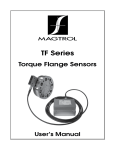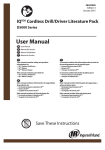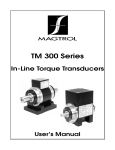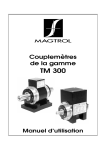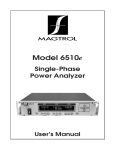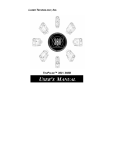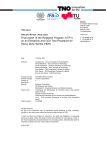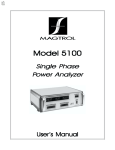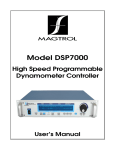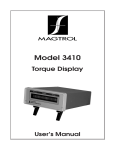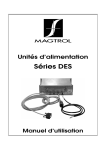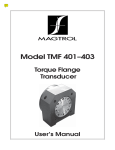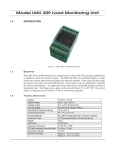Download TF Series User`s Manual
Transcript
TF Series Torque Flange Sensors User’s Manual Purchase Record Please record all model numbers and serial numbers of your Magtrol equipment, along with the general purchase information. The model number and serial number can be found on either a silver identification plate or white label affixed to each unit. Refer to these numbers whenever you communicate with a Magtrol representative about this equipment. Model Number: _____________________________ Serial Number: _____________________________ Purchase Date: _____________________________ Purchased From: _____________________________ While every precaution has been exercised in the compilation of this document to ensure the accuracy of its contents, Magtrol assumes no responsibility for errors or omissions. Additionally, no liability is assumed for any damages that may result from the use of the information contained within this publication. Copyright Copyright ©2009 Magtrol, Inc. All rights reserved. Copying or reproduction of all or any part of the contents of this manual without the express permission of Magtrol is strictly prohibited. Second English Edition, revision F – July 2011 Safety Precautions Warning! In order to minimize risks, it is of utmost importance to respect the current safety standards when planning, configuring and operating the Torque measurement drive train. Caution: Operate the TF Series Torque Flange Sensor with great caution! The sensor may be irreversibly damaged if impacted mechanically (fall), chemically (acids) or thermally (hot air, vapor). 1. Make sure that all Magtrol electronic products are earth-grounded, to guarantee personal safety and proper operation. 2. Check line voltage before operating electronic equipment. 3. Make sure that all rotating parts are equipped with appropriate safety guards. Note: 4. 5. 6. 7. Detailed information regarding safety guards can be found in Section 2.6 – Protective Systems. Periodically check all connections and attachments. Always wear protective glasses when working close to rotating elements. Never wear a necktie or baggy clothes when standing close to rotating elements. Never stand too close or bend over the rotating drive chain. Qualified Personnel Persons in charge of installing and operating the TF Series Torque Flange Sensor must have read and understood this User’s Manual, paying extra close attention to all safety-related information. The TF Sensor is a high-precision product integrating the most recent measurement techniques. The sensor can give rise to residual dangers if used and manipulated in a non-compliant way by unqualified personnel. This sensor must be handled by qualified personnel according to the technical requirements and the above-mentioned safety instructions. This is also true when using torque flange accessories. i Table of Contents Magtrol TF Series Torque Flange Sensors Residual Hazards Sensor performance is only one element in torque measurement. Safety is of equal importance. There are possible residual hazards when operating rotating test equipment and it is the responsibility of the designer, the manufacturer and the user to minimize these hazards. In addition to general safety precautions, residual hazards are highlighted in this manual by using the following symbols: Please read the Preface for a more detailed description of each symbol. Proper Use The use of TF Series Torque Flange Sensors is exclusively restricted to torque and rotational speed measuring tasks and directly-related control and regulating tasks. Any further use shall be deemed to be improper. For safe operation, the TF Sensor and its accessories may only be used according to the data and specifications given in this User’s Manual. Safe operation can be guaranteed only when the sensor is correctly transported, stored, installed, mounted and used. Modifications The TF Torque Flange Sensor and its accessories may not be modified without the express consent of Magtrol. Magtrol is not be liable for any consequential damages resulting from unauthorized modifications. ii Revisions to This Manual The contents of this manual are subject to change without prior notice. Should revisions be necessary, updates to all Magtrol User’s Manuals can be found at Magtrol’s website at www.magtrol.com/support/manuals.htm. Please compare the date of this manual with the revision date on the website, and then refer to the manual’s Table of Revisions for any changes/updates that have been made since this edition. Revision Date Second English Edition, revision F – July 2011 Table of Revisions Date Edition 07/04/11 2nd edition, rev. F 11/12/09 2nd edition, rev. E 06/18/09 03/31/09 03/27/09 06/03/08 2nd edition, rev. D 2nd edition, rev. C 2nd edition, rev. B 2nd edition, rev. A Change Section(s) text concerning parasitic forces updated 4.4 New information about the cardan shaft was added in section 2.2.4.5. New information about radial forces, axial forces and dynamic limit was added to section 4.4. Changed values for TF 220 Added (N/C for 5W conditioner) to pin 7 0.5 mm distance changed to 1.5 mm distance New design for standard speed sensor iii 2.2.4.5, 4.4 2.2.4.1 2.5.3.1 2.4.1 1.2, 2.41 Table of Contents Safety Precautions..........................................................................................................................i Qualified Personnel............................................................................................................................................i Residual Hazards.................................................................................................................................................ii Proper Use.................................................................................................................................................................ii Modifications.........................................................................................................................................................ii Revisions to This Manual...............................................................................................................iii Revision Date................................................................................................................................................................ iii Table of Revisions..................................................................................................................................................... iii Table of Contents.......................................................................................................................... iv Table of Figures......................................................................................................................................................... vi Preface............................................................................................................................................... vii Purpose of This Manual........................................................................................................................................vii Who Should Use This Manual.............................................................................................................................vii Manual Organization............................................................................................................................................vii 1. Introduction..................................................................................................................................1 1.1 System Components............................................................................................................................................ 1 1.1.1 Measuring Flange................................................................................................................................. 1 1.1.2 HF Transmitter........................................................................................................................................ 1 1.1.3 Conditioner.............................................................................................................................................. 2 1.1.4 Coaxial Cable.......................................................................................................................................... 2 1.1.5 Speed Measurement Option.............................................................................................................. 3 1.1.6 Signal Processor/Display Unit....................................................................................................... 3 1.2 Data Sheet................................................................................................................................................................. 4 2. Installation / Configuration.................................................................................................15 2.1 Initial Cleaning.................................................................................................................................................. 15 2.2 Measuring Flange Mounting....................................................................................................................... 16 2.2.1 Alignment................................................................................................................................................ 16 2.2.2 Coupling Selection............................................................................................................................. 16 2.2.3 Mounting Considerations............................................................................................................... 18 2.2.4 Mounting Procedure......................................................................................................................... 20 2.3 HF Transmitter Mounting............................................................................................................................. 23 2.4 Speed Sensor Mounting................................................................................................................................... 23 2.4.1 Standard Sensors................................................................................................................................ 24 2.4.2 High-temperature Sensors............................................................................................................. 24 2.5 Electrical Connections................................................................................................................................ 25 2.5.1 Connecting the HF Transmitter to the Conditioner . .................................................... 25 2.5.2 Connecting the (Optional) Speed Sensor to the Speed Conditioner....................... 25 2.5.3 Connecting the Conditioner to a Signal Processor/Display Unit........................... 26 2.6 Protective Systems........................................................................................................................................... 27 3. Startup...........................................................................................................................................29 3.1 Powering Up the System.................................................................................................................................. 29 iv Magtrol TF Series Torque Flange Sensors Table of Contents 3.2Offset and Gain................................................................................................................................................... 30 4. Measurement Considerations..............................................................................................31 4.1 Dynamic Torque.................................................................................................................................................. 31 4.2 Determining the Natural Frequency of a Drive Train................................................................. 31 4.3 Maximum Dynamic Amplitude...................................................................................................................... 33 4.4 Parasitic Forces.................................................................................................................................................. 34 4.5 Temperature Compensation.......................................................................................................................... 35 5. Operating Principles................................................................................................................36 5.1 Telemetry Principle......................................................................................................................................... 36 5.2 Signal Transmission......................................................................................................................................... 36 5.2.1 Measuring Flange to Conditioner............................................................................................. 37 5.2.2 Conditioner to Measuring Flange............................................................................................. 37 5.2.3 Speed Sensor to Speed Conditioner........................................................................................... 37 6. Troubleshooting / Maintenance..........................................................................................38 6.1 Dismounting the Measuring Flange........................................................................................................ 38 6.2LED Indicators...................................................................................................................................................... 39 6.3 Troubleshooting................................................................................................................................................ 39 6.3.1Output Signal Remains Between -10 V and -12 V.................................................................... 40 6.3.2 No Output Signal / No Reaction.................................................................................................... 41 6.3.3 Signal at ¾ of its Nominal Value When Unloaded............................................................. 42 6.3.4 Unstable Signal.................................................................................................................................... 43 6.3.5 "0" Offset with Normal Signal...................................................................................................... 44 6.4 Repair........................................................................................................................................................................ 45 6.4.1 Defect Report........................................................................................................................................ 45 6.4.2 Returning to Magtrol...................................................................................................................... 45 Magtrol Limited Warranty..........................................................................................................46 Claims.............................................................................................................................................................................. 46 Service Information.......................................................................................................................47 Returning Magtrol equipment for Repair and/or Calibration...................................................... 47 Returning Equipment to Magtrol, Inc. (United States)................................................................. 47 Returning Equipment to Magtrol SA (Switzerland)...................................................................... 47 v Table of Contents Magtrol TF Series Torque Flange Sensors Table of Figures 1. Introduction Figure 1–1 Figure 1–2 Figure 1–3 Figure 1–4 Figure 1–5 TF Series Torque Flange Sensor Kit..........................................................................................................1 Conditioner for TF 209 – TF 217 Torque Flange Sensors........................................................................2 Electronics Module for TF 218 – TF 220 Torque Flange Sensors............................................................2 Mounted TF Torque Flange Sensor with Speed Measurement Option......................................................3 Model 3410 Torque Display......................................................................................................................3 2. Installation / Configuration Figure 2–1 Installation Overview..............................................................................................................................15 Figure 2–2 Angular and Radial Misalignment..........................................................................................................16 Figure 2–3 Incorrect Mounting..................................................................................................................................16 Figure 2–4 Coupling Options for Angular Misalignment Correction.......................................................................17 Figure 2–5 Coupling Options for Radial Misalignment Correction..........................................................................17 Figure 2–6 Mounting Flange and Coupling Specifications.......................................................................................18 Figure 2–7 Measuring Flange Spacing.....................................................................................................................19 Figure 2–8 Mounted TF.............................................................................................................................................19 Figure 2–9 Screw Tightening Order...........................................................................................................................20 Figure 2–10 Flange Mounting of TF 209 to TF 212 and TF 220 Sensors.................................................................21 Figure 2–11 Flange Mounting of TF 213 to TF 219 Sensors....................................................................................21 Figure 2–12 Coupling Mounting to Measuring Flange/Mounting Flange Assembly................................................21 Figure 2–13 Coupling Mounting to Measuring Flange (TF 209, 210, 211 and 220)...............................................22 Figure 2–14 Coupling Mounting to Measuring Flange (TF 213 – 219)...................................................................22 Figure 2–15 Mounting Flange to Measuring Flange/Coupling Assembly................................................................22 Figure 2–16 HF Transmitter Installation...................................................................................................................23 Figure 2–17 Standard Speed Sensor Installation.......................................................................................................24 Figure 2–18 High-temperature Speed Sensor Installation........................................................................................24 Figure 2–19 Conditioner Connections.......................................................................................................................25 Figure 2–20 Conditioner Connector Pin Configuration............................................................................................26 Figure 2–21 ER 116 Cable Configuration.................................................................................................................26 Figure 2–22 ER 117 Cable Configuration.................................................................................................................27 Figure 2–23 Spacing Between Flange and Guard.....................................................................................................28 Figure 2–24 Example of Protective System...............................................................................................................28 3. Startup Figure 3–1 Figure 3–2 Figure 3–3 Figure 3–4 Green and Yellow LEDs...........................................................................................................................29 Red LED..................................................................................................................................................29 Zero Calibration of 1.5 W Conditioner (TF 209 to TF 217 Sensors)......................................................30 Zero Calibration 5 W Conditioner (TF 218 to TF 220 Sensors).............................................................30 4. Measurement Considerations Figure 4–1 Simplified Physical Drive Train Model...................................................................................................32 Figure 4–2 Drive Train Transfer Curve.....................................................................................................................32 Figure 4–3 Admissible Dynamic Load.......................................................................................................................33 5. Operating Principles Figure 5–1 Telemetry Principle Applied to TF Torque Flange Sensors.....................................................................36 Figure 5–2 Signal Transmission Block Diagram.......................................................................................................36 6. Troubleshooting / Maintenance Figure 6–1 Improper Dismounting............................................................................................................................38 vi Preface Purpose of This Manual This manual contains all the information required for the setup, connection and general use of Magtrol’s Torque Flange Sensors of TF200 series. Please read this manual in its entirety before operating. Keep the manual in a safe place for quick reference whenever a question should arise. Who Should Use This Manual This manual is intended for those who install Torque Flange Sensors on a bench test or to use it to determine the couple on a transmission chain. The operator is assumed to have the necessary technical training in mechanical engineering and electronics to enable him to install these Torque Flange Sensors. Manual Organization This section gives an overview of the structure of the manual and the information contained within it. Some information has been deliberately repeated in different sections of the document to minimize cross-referencing and to facilitate understanding through reiteration. The structure of the manual is as follows: Chapter 1: Introduction – Contains the technical data sheets for the Torque Flange Sensors of TF200 series, which describe the units and provide an overview of their possible applications. Chapter 2: Installation/Configuration – Provides the information needed for the setup and connection of the Torque Flange Sensors. Chapter 3: STARTUP – Give the instructions to start the system and adjust the zero of the measuring chain. Chapter 4: MEASUREMENT CONSIDERATIONS – Describes the limits of measures. Chapter 5: OPERATING PRINCIPLES – Contains information on lubrication procedures and provides recommendations for the calibration and checking of the measuring current and voltage. Chapter 6: TROUBLESHOOTING/MAINTENANCE – Give the procedure to follow in case of breakdown of a Torque Flange Sensors TF. vii Preface Magtrol TF Series Torque Flange Sensors Conventions Used in This Manual The following symbols and type styles may be used in this manual to highlight certain parts of the text: Note: Caution: This is intended to draw the operator’s attention to complementary information or advice relating to the subject being treated. It introduces information enabling the correct and optimal function of the product. This is used to draw the operator’s attention to information, directives, procedures, etc. which, if ignored, may result in damage to the material being used. The associated text describes the necessary precautions to take and the consequences that may arise if these precautions are ignored. WARNING! This Introduces Directives, procedures, precautionary measures, etc. which must be executed or followed with the utmost care and attention, otherwise the personal safety of the operator or third party may be at risk. The reader must absolutely take note of the accompanying text, an d act upon it , before proceeding further. viii 1. Introduction 1.1 System Components The complete TF Series torque measuring system consists of the following four primary components: 1. Measuring Flange with Signal Amplifier 2. HF Transmitter 3. Conditioner 4. Coaxial Cable (4 m) HF Transmitter Measuring Flange Conditioner (mounted on heatsink) Coaxial Cable Figure 1–1 TF Series Torque Flange Sensor Kit System options include the Speed Sensor and Conditioner, and the 3410 Display 1.1.1 Measuring Flange The measuring flange represents the rotor part of the torque sensor. It is made of steel and contains 4 strain gauges in full-bridge configuration, an amplifier, a low-pass filter and an A/D converter. It is fitted with an electromagnetic track around its circumference which acts as an antenna for sending telemetric transmissions to the HF transmitter and, ultimately, the conditioner. 1.1.2 HF Transmitter The high-frequency transmitter represents the stator part of the transducer. This transmitter receives the signal from the measuring flange and relays it to the conditioner. 1 Chapter 1 – Introduction 1.1.3 Magtrol TF Series Torque Flange Sensors Conditioner The torque conditioner supplies power to the measuring flange, via the HF transmitter, and collects the torque signal measured by the system. To display measured values, the conditioner must be connected to a Magtrol 3410 Torque Display (see Section 1.1.6 – Signal Processor/Display Unit) or similar device. TF Model TF 209 – TF 217 TF 218 – TF 220 Power 1.5 W 5W Mounting Mounted on heatsink (for heat dissipation) Mounted inside electronics module Figure 1–2 Conditioner for TF 209 – TF 217 Torque Flange Sensors 5 W Conditioner Figure 1–3 Electronics Module for TF 218 – TF 220 Torque Flange Sensors 1.1.4 Coaxial Cable The shielded RG-58 coaxial cable between the HF transmitter and the conditioner has an impedance of 50 Ohms and is 4 meters long (8 m, 12 m, 16 m and 20 m cables are available as an option). 2 Chapter 1 – Introduction Magtrol TF Series Torque Flange Sensors 1.1.5 Speed Measurement Option When ordered with the optional speed measurement capability, the TF Torque Sensor is fitted with a toothed rim with the speed sensor attached to the exterior (as shown in the figure below). Speed Sensor TF Measuring Flange fitted with toothed rim Connection Cable Speed Conditioner Figure 1–4 Mounted TF Torque Flange Sensor with Speed Measurement Option 1.1.6 Signal Processor/Display Unit Available as a system option, Magtrol's 3410 Torque Display processes the torque and speed signals from the TF Sensor and displays the measured values and calculated power. For additional data processing, the unit has an RS-232 interface (cable sold separately) for connection to a PC and is delivered with Magtrol's Torque 1.0 Software. Torque 1.0 is a user-friendly Windows® executable program, developed under LabVIEW™, used to automatically collect torque, speed and mechanical power data. The data can be printed, displayed graphically or quickly saved as a Microsoft® Excel spreadsheet. Figure 1–5 Model 3410 Torque Display 3 Chapter 1 – Introduction 1.2 Magtrol TF Series Torque Flange Sensors Data Sheet M AGTROL TF Data Sheet TF Series Torque Flange Sensor Features • • • • • • • • • • • • • • • HF Transmitter Measuring Flange Completetorquemeasuringsystemconsistingof: • Measuringflangewithsignalamplifier • HFtransmitter • Conditioner • 4mcoaxialcable Contactlesssignaltransmission:viatelemetry Torquerange:50N·mto150,000N·m Highaccuracy:0.1%to0.25% Overloadcapacity:upto200%(limitofadhesion) Measuringrange:200% Brakingtorque:400% Compact,easy-to-mountdesign Hightorsionalstiffness Bearingless:maintenanceandwear-free Excellentnoiseimmunityandshockresistance Protectionclass:IP42(IP54optional) 24VDCstandardpowersupply Integratedspeedsensorandconditioner(option):for rotationalspeedmeasurement Hightemperaturecapability:upto125°C(optional) Coaxial Cable DesCrIPtION ThecontactlessdesignoftheTorqueFlangeSensorpermitsagap ofupto5mm(typically1to3mm)betweentherotorantenna andHFtransmitter,whichmakesthesignalacquisitioninsensitive toanyaxialorradialmisalignment.Anotheradvantageofthis torque measurement system is its insusceptibility to signal interference—due to the fact that, unlike other designs, the antennadoesnotneedtobeloopedaroundthemeasuringflange. Additionally,aprotectivecovercanbemountedclosetotheTF Sensorwithnoeffectonthesignal. Withitscompact,bearingless,maintenance-freedesign,thenew TFTorqueFlangeSensorfromMagtrolbringsmanyappealing advantagestotorquemeasurementapplications.TheTF’shigh torsionalrigiditysupportsdirectmountingonthemachineshaft orflange,avoidingtheuseofcouplingsononeside.Thisallows easyintegrationintoatestsystem,shortenstheoveralllength ofthetestbenchandreducescosts. Based on strain-gauge technology, theTF Sensor’s precise telemetrysystemenableshighlyaccuratesignaltransmission. Asignalamplifiermountedinthemeasuringflangeamplifies the measuring signal, modulates it to high frequency and transmits it inductively (via the HF transmitter) to the conditioner. In the conditioner, the digitized torque signal is transformed into an analog output signal of ±5VDC. RotationalspeedcanbemeasuredandconvertedtoaTTL outputsignalwiththeoptionalspeedsensor. 1 Model TF Torque Flange Sensor aPPLICatIONs TFTorqueFlangeSensorsmeasurebothstaticanddynamic torque on stationary and rotating shafts. They are used in generalcombustionengine,electricmotorandgearboxtest benches; and can also be mounted inline for active torque monitoring of transmissions, powertrains, wind generators, gasturbines,boatengines,etc. 4 www.magtrol.com Chapter 1 – Introduction Magtrol TF Series Torque Flange Sensors Diagrams TF BLOCK DIaGraM HF TRANSMITTER Switch 4 m Coaxial Cable RG-58 (50 Ohms) CONDITIONER option Torque ±5 VDC Torque Speed sensor Z pulses/ revolution Signal amplifier Power supply 24 VDC ±10% 350 mA Rotational Speed SPEED CONDITIONER Rotational speed TTL (Option) Strain Gauge Bridge for torque measurement Torque sensor sYsteM CONFIGuratION Brake Frein TF Torque Flange Sensor Couplemètre TF HF Transmitter Transmetteur HF Motor under HF Transmitter Moteur à testertest Model 3410 Afficheur couple 3410 Torque de display Conditioner Conditionneur 2 5 M AGTROL Chapter 1 – Introduction Magtrol TF Series Torque Flange Sensors Specifications TF MODeL ratINGs Model TF 210 TF 211 TF 212 TF 213 TF 214 TF 215 TF 216 TF 217 TF 218 TF 219 TF 220 Model TF 210 TF 211 TF 212 TF 213 TF 214 TF 215 TF 216 TF 217 TF 218 TF 219 TF 220 rated Torque N·m 50 100 200 500 1,000 2,000 5,000 10,000 20,000 50,000 100,000 Sensor Weight *** kg 2.1 2.2 2.2 3.3 3.3 5.2 9.3 9.3 42.7 43.3 36.0 overload accuracy Capacity Class % of R.T. 200% 0.1% 200% 0.1% 200% 0.1% 200% 0.1% * 200% 0.1% * 200% 0.1% * 200% 0.1% ‡ 150% 0.1% 200% 0.20% – 0.25% ‡ 180% 0.20% – 0.25% ‡180% 0.25% – 0.30% Maximum Speed rpm 17,000 17,000 17,000 13,000 13,000 10,000 8,000 8,000 3,000 3,000 3,000 Moment of inertia kg·m² 2.996 × 10-3 3.172 × 10-3 3.138 × 10-3 7.803 × 10-3 7.818 × 10-3 1.868 × 10-2 4.747 × 10-2 4.706 × 10-2 9.635 × 10-1 9.724 × 10-1 1.070 × 10 0 lb·ft·s² 2.211 × 10-3 2.341 × 10-3 2.316 × 10-3 5.758 × 10-3 5.769 × 10-3 1.378 × 10-2 3.503 × 10-2 3.472 × 10-2 7.109 × 10-1 7.175 × 10-1 7.895 × 10-1 * ** *** ‡ number of Teeth ** Z 70 70 70 91 91 113 133 133 283 283 270 Torsional Deformation Stiffness angle N·m/rad ° 0.040 7.16 × 104 1.25 × 105 0.046 2.05 × 105 0.056 7.16 × 105 0.040 9.55 × 105 0.060 2.86 × 106 0.040 7.16 × 106 0.040 1.25 × 107 0.046 0.040 2.86 × 107 6.82 × 107 0.042 3.37 × 108 0.017 Available upon request: • Torque up to 150,000 N·m • High speed versions Linearity-hysterese error 0.05% on request Inductive speed detection available on request. Add 0.8 kg to 2.8 kg to weight, depending on configuration, for electronic devices attached to the sensor (transmitter, receiver, speed conditioner). Dynamic torque peak values for Models TF 217, TF 219 and TF 220 are due to force transmission limit of mounting screws. Moment of Inertia (X axis) ratINGs COMMON tO aLL tF seNsOrs Torque MeaSureMenT Maximum Dynamic Torque Without Damage (Overload Limit) SpeeD MeaSureMenT (option) Number of Teeth Speed Pick-up Transducer Minimum Speed Detection environMenT Rated Temperature Range Storage Temperature Range Extended Temperature Range (option) Temperature Influence on Zero Protection Class inpuT anD ouTpuT SignalS Power Supply Torque Output Signal (rated / max) Passband Frequency Speed Output (option) 3 400% of Rated Torque Depending on the size; Refer to Z under Model Ratings Magnetoresistive 0.5 rpm +10 °C to +85 °C -25 °C to +85 °C -30 °C to +125 °C 0.01% / °C IP 42 (optional IP 54) TF 209 – TF 217: 24 V DC ±10%, max 350 mA TF 218 – TF 220: 100–240 V AC ±5 V DC / ±10 V DC 0 to 1 kHz (-3 dB) TTL (pulses per revolution corresponds with number of teeth) 6 M AGTROL Chapter 1 – Introduction Magtrol TF Series Torque Flange Sensors Sensor Dimensions TF tF 210 tO tF 212 50 20 4.5 Transmitter HF 30 2x 10 30 Rotor antenna 5 Air gap 2 mm .05 ±0 100 39 H7 2.5 Speed sensor 115 18 45.5 4 8x M6x10 8x M6 86 2.5 39 H7 105 M 12x1 Air gap 1.5 mm 0 - 0.2 tF 213 aND tF 214 Rotor antenna Air gap 2 mm 8x 18 5 M1 0 8x 10.1 30 8x Transmitter HF 4.5 30 2x 20 10 50 75 H7 .05 3 75 H7 ±0 132 1.5 3 M 12x1 10 136.5 Air gap 1.5 mm Speed sensor 115 2.5 18 0 46 - 0.2 4 7 M AGTROL Chapter 1 – Introduction Magtrol TF Series Torque Flange Sensors Sensor Dimensions TF tF 215 10 20 12.2 30 5 8x 30 Air gap 2 mm Rotor antenna 4.5 8x 2x Transmitter HF 20 50 3 169.4 90 H7 90 H7 164 M 12x1 Air gap 1.5 mm 3 8x M12 Speed sensor .05 0 ±0 13 115 6.5 18 0 47 - 0.2 tF 216 Transmitter HF 4.5 Air gap 2mm 8x 14.2 8x 5 30 21.5 Rotor antenna 30 2x 20 10 50 11 8x M14 5.5 15 199.5 110 H7 110 H7 194 M 12x1 Air gap 1.5mm 3 Speed sensor .05 ±0 115 19 16 0 55 - 0.2 5 8 M AGTROL Chapter 1 – Introduction Magtrol TF Series Torque Flange Sensors Sensor Dimensions TF tF 217 Transmitter HF 10 50 Air gap 2 mm 20 8x 8x 5 30 24.5 Rotor antenna 16.2 4.5 30 2x 11 199.4 110 H7 194 110 H7 M 12x1 Air gap 1.5 mm 3 8x M16 Speed sensor 5.5 15 .05 ±0 115 19 16 0 56.5 - 0.2 tF 218 aND tF 219 Rotor antenna 30 Air gap 3 mm 8x 8x 30.5 47 5 40 Transmitter HF 25 10 60 3 420 290 H7 290 H7 424.5 M12x1 Air gap 1.5 mm 7 16x M30 115 Speed sensor 0 35 .05 ±0 24 4 0 55 - 0.2 6 9 M AGTROL Chapter 1 – Introduction Magtrol TF Series Torque Flange Sensors Sensor Dimensions TF tF 220 25 40 2x Transmitter HF Air gap 3 mm Rotor antenna 4.5 5 30 10 60 16x M 30 0.1 5± 32 275H7 6 268 275H7 400 6 405 M12x1 115 Speed sensor Air gap 1.5 mm 2.5 7 10 24 0 104- 0.3 M AGTROL Chapter 1 – Introduction Magtrol TF Series Torque Flange Sensors Speed Sensor Dimensions TF staNDarD sPeeD seNsOr ThestandardspeedsensorisdeliveredwithTFTorqueFlangeSensorsorderedwiththespeedmeasurementoption. HF Transmitter Connection Cable (to speed conditioner) 90 Speed Sensor ° 115 44 19 M 12x1 10 1.5 mm 44 SW17 2.5 50 17 HIGH-teMPerature sPeeD seNsOr Thehigh-temperaturespeedsensorisdeliveredwithTFTorqueFlangeSensorsorderedwithboththespeedmeasurementand extendedtemperaturerangeoptions. Ø HF Transmitter 10° 15 5 . R5 .5 0 R1 High-temperature Speed Sensor 6.4 ° 90 0.5 mm – 2 mm 20 45 5 O-Ring 4.5 2.4 9 45 Ø15 Ø12 8 11 M AGTROL Chapter 1 – Introduction Magtrol TF Series Torque Flange Sensors Conditioner Dimensions TF 8.5 60 4.5 83 78 4x 25 A 4x 0 5 95 tF 210 tO tF 217 - staNDarD 5 0 A 47 100 86 14 0 Heatsink Conditioner Conditioner - standard version (1.5 W) mounted on heatsink for heat dissipation 60 8.5 8x 83 78 4.5 25 A 8x 211 121 0 5 95 tF 210 tO tF 217 - wItH sPeeD OPtION 5 0 Torque Conditioner 47 216 202 130 86 14 0 A Speed Conditioner Heatsink Conditioner - speed version (1.5 W) mounted on heatsink for heat dissipation 9 12 M AGTROL Chapter 1 – Introduction Magtrol TF Series Torque Flange Sensors Conditioner Dimensions TF tF 218, tF 219 aND tF 220 A 6 160 6.6 4x 4x 11 135 25 0 350 360 90 0 10 A Conditioner (5 W) mounted inside electronics module 10 13 M AGTROL Chapter 1 – Introduction Magtrol TF Series Torque Flange Sensors Ordering Information TF OPtIONs aND OrDerING INFOrMatION MoDel nuMBer: TF 2 /0 1 MODEL TF 2 1 0 – 2 2 0 SPEED MEAUSUREMENT • without (standard) • with (option) 1 2 sYsteM OPtIONs Model 3410 Torque Transducer Display MagtroloffersthenewModel3410Displaywhichsupplies power to any TF Sensor and displays torque, speed and mechanicalpower.Featuresinclude: AdjustableEnglish,metricandSItorqueunits Large,easy-to-readvacuumfluorescentdisplay Built-inself-diagnostictests Overloadindication Tarefunction RS-232interface Torqueandspeedoutputs Closed-boxcalibration IncludesMagtrolTorque1.0Software Torque 1.0 Software Magtrol’sTorque1.0Softwareisaneasy-to-useWindows® executable program, used to automatically collect torque, speedandmechanicalpowerdata.Thedatacanbeprinted, displayed graphically or quickly saved as a Microsoft® Excelspreadsheet.StandardfeaturesofMagtrol’sTorque1.0 Softwareinclude:peaktorquecapture,multi-axesgraphing, measuredparametervs.time,adjustablesamplingratesand polynomialcurvefitting. MoDel nuMBer: er 1 -0 CABLE END • 14-Pin Connector 16 • Pigtail Wires 17 (For use with 3410 Display or DSP6001 Controller) CABLE LENGTH • 5m • 10 m • 20 m 1 2 3 Couplings For theTF 210 –TF 219Torque Flange Sensors, Magtrol offers double-element high-speed couplings to provide compensation for axial, angular and radial misalignments. Engagedbyfriction,theyaretorsionally-stiffandminimize reaction forces. BSD 9200 Series couplings are wear and maintenance-freeandfeatureacompactdesign. TF Torque Sensor TF 210 to TF 211 TF 212 TF 213 and TF 214 TF 215 TF 216 TF 217 TF 218 and TF 219 BSD Moduflex® 9200 Couping BSD 9200-2.8-200 BSD 9200-4.5-200 BSD 9200-17-200 BSD 9200-28-200 BSD 9200-64-200 BSD 9200-110-200 BSD 9200-640-200 Due to the continual development of our products, we reserve the right to modify specifications without forewarning. www.magtrol.com MaGtrOL INC 70 Gardenville Parkway Buffalo, New York 14224 USA Phone: +1 716 668 5555 Fax: +1 716 668 8705 E-mail: [email protected] MaGtrOL sa Route de Montena 77 1728 Rossens / Fribourg, Switzerland Phone: +41 (0)26 407 3000 Fax: +41 (0)26 407 3001 14 E-mail: [email protected] Subsidiaries in: Germany • France China • India Worldwide Network of Sales Agents TF-US 02/11 • • • • • • • • • Connection Cables 2. Installation / Configuration Caution: before completing the assembly and mounting, it is advised to first power up the system (see Section 3.1) in order to check the signal transmission. rotor antenna mounting flange coupling TF Measuring Flange HF Transmitter Coaxial Cable Conditioner Figure 2–1 Installation Overview 2.1 Initial Cleaning Prior to installing the TF Series Torque Flange Sensor, all contact surfaces including the measuring flange, coupling element and mounting flange must be carefully cleaned and degreased. This will guarantee optimal transmission of the measured torque signal. Use a soft cloth lightly dampened with alcohol to avoid any abrasion. Be careful to prevent any alcohol from entering the flange or coming in contact with the rotor antenna during cleaning. Caution: Avoid any use of overly aggressive solvents. These can damage the rotor antenna while cleaning. If necessary, acetone may be used (instead of alcohol) to remove encrusted deposits. It is advised to clean all flange and coupling contact surfaces each time the drive train is reconfigured. 15 Chapter 2 – Installation / Configuration Magtrol TF Series Torque Flange Sensors 2.2 Measuring Flange Mounting 2.2.1 Alignment The TF Series Torque Flange Sensors are easy to install by design. However, it is important to achieve the best possible alignment of the various components of the measurement drive train. Angular and radial misalignments (as illustrated below) must be avoided. ANGULAR MISALIGNMENT RADIAL MISALIGNMENT Figure 2–2 Angular and Radial Misalignment The admissible angular and radial misalignment is 0.3° and 0.04 mm, respectively. By using proper couplings, modest misalignments can be compensated. Coupling Selection Driven Element To avoid excessive extraneous loads, do not couple the driving elements directly to the driven part of the measuring chain by means of the measuring flange. A coupling is necessary. Mounting Flange 2.2.2 TF Measuring Flange Figure 2–3 Incorrect Mounting 16 Chapter 2 – Installation / Configuration Magtrol TF Series Torque Flange Sensors 2.2.2.1 Couplings for Angular Misalignment In case of a slight angular error, a one-piece lamella coupling, cardan shaft or bellows coupling may be used. One-piece Lamella Cardan Shaft Bellows Figure 2–4 Coupling Options for Angular Misalignment Correction 2.2.2.2 Couplings for Radial Misalignment If the shaft mounting shows a slight radial misalignment, a two-piece lamella coupling, double cardan shaft or bellows coupling may be used. These elements provide the system with two degrees of freedom in order to compensate for a slight radial misalignment. Two-piece Lamella Double Cardan Shaft Bellows Figure 2–5 Coupling Options for Radial Misalignment Correction 17 Chapter 2 – Installation / Configuration Mounting Considerations Mounting Flange and Coupling Specifications Minimum Tensile Strength 700 N/mm² Minimum Hardness 25 HRC Roughness Ra 1.6 Minimum Face Flatness 0.03 mm Centering Tolerance Ø g6 TF Measuring Flange 1.6 Coupling Ø g6 0.03 Rotor Antenna 1.6 Ø g6 0.03 Mounting Flange 2.2.3 Magtrol TF Series Torque Flange Sensors Figure 2–6 Mounting Flange and Coupling Specifications • • The mounting flange or coupling mounted on the same side as the rotor antenna must have a diameter equal to or smaller than the rotor antenna diameter. To achieve the best possible centering of the measuring flange, the mounting flanges and couplings should use a centering device with a g6 tolerance on the outside diameter as illustrated in Figure 2–6 Mounting Flange and Coupling Specifications. The measuring flange is fitted with a centering bore (tolerance H7) on each face. Note: • If the mounting flange is also fitted with a centering bore, an intermediate centering washer may be used (see Figure 2–8 Mounted TF). A minimum distance of 10 mm between the main body of the mounting flange and its center piece (as illustrated in Figure 2–7 Measuring Flange Spacing) is necessary to avoid any disturbance when transmitting the HF telemetry signal. 18 Chapter 2 – Installation / Configuration Magtrol TF Series Torque Flange Sensors TF Measuring Flange Mounting Flange Rotor Antenna 10 mm (min.) Figure 2–7 Measuring Flange Spacing • • Check the lengths of the screws and be sure to avoid any contact between the screws and the opposite part of the measuring flange (see Figure 2–8 Mounted TF). Ensure a 0.1 to 0.2 mm clearance between the centering hole of the measuring flange and the mounting flange centering washer. Exemple de centrage Mounting Flange avec une rondelle Centering Washer min. clearance jeu min. de 0.1-0.2 mm 0.1 mm– 0.2 mm Measuring Flange Centering Hole Figure 2–8 Mounted TF 19 Chapter 2 – Installation / Configuration 2.2.4 Magtrol TF Series Torque Flange Sensors Mounting Procedure Since all TF Sensors are reversible, the component that is to be mounted on the same side as the measuring flange's rotor antenna must be mounted first. The options/mounting orders are as follows: Option First Step A Mounting Flange to Measuring Flange (see Section 2.2.4.2) B Coupling to Measuring Flange (see Section 2.2.4.4) 2.2.4.1 Second Step Coupling to Measuring Flange/Mounting Flange Assembly (see Section 2.2.4.3) Mounting Flange to Measuring Flange/ Coupling Assembly to (see Section 2.2.4.5) Mounting Screws The measuring flange must be mounted with 8.8/10.9/12.9 quality screws applying the specific fastening torque listed in the following table. TF Sensor Model TF 209 TF 210 TF 211 TF 212 TF 213 TF 214 TF 215 TF 216 TF 217 TF 218 TF 219 TF 220 Fastening Torque [N·m] Friction Friction Coefficient Coefficient μ = 0.10 μ = 0.14 Fastening Screw Size Screw Class M6 8.8 9.0 11.3 M6 10.9 13.2 16.5 M10 10.9 63 79 M12 M14 M16 10.9 12.9 12.9 108 201 309 137 255 395 M30 10.9 1 775 2 274 M30 10.9 1775 2 274 The mounting screws must be tightened in the following order. 8 1 2 7 6 3 6 5 1 3 4 11 4 5 1 12 7 16 7 8 6 2 TF 209 – TF 219 2 5 13 10 8 15 4 9 14 3 TF 220 Figure 2–9 Screw Tightening Order Note: When faced with alternating loads, secure the screws in their threads with thread locker in order to avoid any loss of preload. Be sure to prevent the thread locker from spilling over. 20 Chapter 2 – Installation / Configuration Magtrol TF Series Torque Flange Sensors 2.2.4.2 Attaching the Mounting Flange to the Measuring Flange Screw the measuring flange onto the mounting flange, firmly attaching it to the driving shaft, as shown in the figures below. Figure 2–10 Flange Mounting of TF 209 to TF 212 and TF 220 Sensors Figure 2–11 Flange Mounting of TF 213 to TF 219 Sensors 2.2.4.3 Attaching the Coupling to the Measuring Flange/Mounting Flange Assembly Screw the single- or double-element coupling, or cardan shaft, onto the measuring flange. Figure 2–12 Coupling Mounting to Measuring Flange/Mounting Flange Assembly 21 Chapter 2 – Installation / Configuration 2.2.4.4 Magtrol TF Series Torque Flange Sensors Attaching the Coupling to the Measuring Flange Figure 2–13 Coupling Mounting to Measuring Flange (TF 209, 210, 211 and 220) Figure 2–14 Coupling Mounting to Measuring Flange (TF 213 – 219) 2.2.4.5 Attaching the Mounting Flange to the Measuring Flange/Coupling Assembly Figure 2–15 Mounting Flange to Measuring Flange/Coupling Assembly Note: When using a cardan shaft, Magtrol recommends the latest generation of GKN series 687 cardan shafts with limited weight. Do not use the over weighted old cardan shafts. Proper mounting position of the cardan shaft is neccessary to ensure proper balancing. Standard applications using a cardan shaft should not exceed 1500-2000 rpm, depending on size and deflection angle. 22 Chapter 2 – Installation / Configuration Magtrol TF Series Torque Flange Sensors 2.3 HF Transmitter Mounting Mount the HF transmitter according to the following specifications: • The HF transmitter must be perfectly centered (laterally) with the rotor antenna and also aligned with the measuring flange axis. • A gap of 2 mm for TF 209 to TF 217 Sensors and 3 mm for TF 218 to TF 220 Sensors must be maintained between the HF transmitter and rotor antenna in order to guarantee the best possible signal transmission. • The HF transmitter must be mounted onto a support which can be easily adjusted both horizontally and vertically. To prevent any disturbance of the transmitted signal, the support must be at least 10 mm away from the HF transmitter rim (see Figure 2–16 HF Transmitter Installation). The support must also be stable in order to prevent excessive vibrating of the HF transmitter and, consequently, avoid electromagnetic coupling problems between the rotor antenna and the HF transmitter. ±2 mm Centering Tolerance 10 mm (min.) HF Transmitter Rotor Antenna 2 mm (TF 209–217) 3 mm (TF 218–220) Support Figure 2–16 HF Transmitter Installation 2.4 Speed Sensor Mounting If the TF Torque Flange Sensor is ordered with optional speed measurement capabilities, the HF Transmitter and the speed sensor must be mounted offset from each other with at least a 90° angle, as shown in Figures 2–17 and 2–18. 23 Chapter 2 – Installation / Configuration 2.4.1 Magtrol TF Series Torque Flange Sensors Standard Sensors The speed sensor must be placed at a 1.5 mm distance from the measuring flange in order to optimize detection. HF Transmitter Connection Cable (to speed conditioner) 90 ° 1.5 mm Speed Sensor Figure 2–17 Standard Speed Sensor Installation High-temperature Sensors The high-temperature speed sensor, delivered with TF Torque Flange Sensors ordered with extended temperature range, must be placed at a 0.5 mm to 2 mm distance from the teeth with a 10° angle to optimize detection. HF Transmitter 10° ° 90 direction 2.4.2 0.5 mm – 2 mm High-temperature Speed Sensor Figure 2–18 High-temperature Speed Sensor Installation 24 Chapter 2 – Installation / Configuration Magtrol TF Series Torque Flange Sensors 2.5 Electrical Connections Having installed the measuring flange and HF transmitter, only two electrical cables (three, with speed measurement option) need to be connected for the system to be operational. Speed Sensor Connection Cable Torque Conditioner Coaxial Cable (connects to HF transmitter) Speed Conditioner (optional) 9-pin Connector (use ER 116 or ER 117 signal cable to connect to signal processor/ display unit) Figure 2–19 Conditioner Connections Avoid running the ER-116/117 signal cable, coaxial cable and speed sensor connection cable through an environment which may be perturbed by electromagnetic fields. These cables should also not be run close to transformers, electric motors or motor drives. If running these TF Torque Flange Sensor cables through such environments cannot be avoided, a minimum distance of 2 feet from potentially perturbing components should be respected. Ideally, these cables should be housed in steel conduit and connected to earth ground, to protect them as much as possible from electromagnetic perturbations. 2.5.1 Connecting the HF Transmitter to the Conditioner Caution: Never shorten the coaxial cable. The system has been tuned in order to optimize the HF transmission using the coaxial cable's original length (as delivered). Connect the HF transmitter to the conditioner with the supplied coaxial cable, utilizing the dedicated connectors. (See Figure 2–19 Conditioner Connections.) 2.5.2 Connecting the (Optional) Speed Sensor to the Speed Conditioner Connect the speed sensor to the speed conditioner with the supplied connection cable, utilizing the dedicated connectors. (See Figure 2–19 Conditioner Connections.) 25 Chapter 2 – Installation / Configuration Magtrol TF Series Torque Flange Sensors 2.5.3 Connecting the Conditioner to a Signal Processor/Display Unit 2.5.3.1 Conditioner Connector For connection to a signal processor/display unit such as a Magtrol 3410 Torque Display or DSP6001 Controller, the conditioner is equipped with a 9-pin D-sub connector. 1 2 6 1. 2. 3. 4. 5. 6. 7. 8. 9. 3 7 4 8 5 9 Torque signal (-5 to +5 V DC) (-10 to +10 V DC for 200%) Torque signal grounding 0 V DC Calibration signal N/C Power supply grounding 0 V DC TTL speed signal (with speed measurement option) Power supply 24 V DC (±10%) (N/C for 5W conditioner) N/C N/C Figure 2–20 Conditioner Connector Pin Configuration Signal Cables Magtrol offers two cable options for connecting the TF Torque Flange Sensor to a signal processor/ display unit (sold separately). Cable Model ER 116 ER 117 Connectors On Conditioner Side On Display Side 9-pin D-sub connector 14-pin Centronics connector 9-pin D-sub connector none (only pigtail wires) 14 7 Tor que O/P 0.. 5V : wh 0V : gr n U : r ed 0V : blu BITE : br n 8 blk 1 2.5.3.2 Tacho TTL O/P : yel gy Shield : yel/ blk Figure 2–21 ER 116 Cable Configuration 26 1 2 3 4 5 6 7 8 9 Chapter 2 – Installation / Configuration Magtrol TF Series Torque Flange Sensors gy Tacho TTL O/P : yel U : r ed 0V : blu 1 2 3 Tor que O/P 0.. 5V : wh 4 0V : gr n 5 BITE : br n Tor que O/P : blk Shield : yel/ blk 6 7 8 9 Figure 2–22 ER 117 Cable Configuration 2.6 Protective Systems Warning! ALL ROTATING PARTS MUST BE FITTED WITH A PROTECTIVE SYSTEM TO ENSURE THAT THE USER, AS WELL AS ALL OTHER SURROUNDING people and OBJECTS, WILL NOT BE INJURED OR DAMAGED AS A RESULT OF THE Drive element BECOMING BLOCKED, A TORQUE OVERLOAD, OR ANY OTHER potential PROBLEM. The following precautions concerning protective equipment of the drive train must be observed: • Protective elements must prevent access to moving parts (during test). • Protective elements must cover all parts which can cause crushing or cutting, and protect against projections of parts having become loose. • Avoid attaching protective elements to rotating parts. • A minimum space of at least 12 mm should be maintained between rotating parts and protective elements. 27 Chapter 2 – Installation / Configuration Magtrol TF Series Torque Flange Sensors 12 mm (min.) Figure 2–23 Spacing Between Flange and Guard Figure 2–24 shows a good example of a protective system. All parts of the bench are accessible, but the cover prevents any risk to the user when closed. Figure 2–24 Example of Protective System 28 3. Startup 3.1 Powering Up the System 1. Switch the system on (power up). 2. Check that all LEDs are illuminated. (If this is not the case, refer to Section 6.2 – LED Indicators). LED Yellow Green Red Indicates Conditioner is powered up. Conditioner receives a (return) signal. Data transmission is OK. HF transmitter is powered up. Figure 3–1 Green and Yellow LEDs Figure 3–2 Red LED 29 Chapter 3 – Startup 3.2 Magtrol TF Series Torque Flange Sensors Offset and Gain Offset and gain of TF Series Torque Flange Sensors are calibrated before delivery. However the zero (offset) may have drifted slightly after mounting the measuring flange (surface flatness, fastening torque of the screws, parasitic forces). If necessary, proceed as follows: 1. Completely unload the measuring chain (no force should be applied to the TF Sensor). 2. Adjust the torque output signal by means of the "Offset" potentiometer placed inside the conditioner in order to obtain a zero value for the torque (0 N·m = 0.000 V). ZERO Calibration Screw Figure 3–3 Zero Calibration of 1.5 W Conditioner (TF 209 to TF 217 Sensors) ZERO Calibration Screw Conditioner Power Supply Unit Figure 3–4 Zero Calibration 5 W Conditioner (TF 218 to TF 220 Sensors) Caution: Never touch the "Gain" adjustment screw. It is only used after a conditioner replacement or repair. 30 4. Measurement Considerations Caution: When performing static measurements, it is possible to go beyond nominal torque and toward the torque limit which causes plastic deformation. When exceeding the nominal torque, any extraneous loads such as axial, shearing and bending forces must be avoided. 4.1 Dynamic Torque Static and dynamic measurements differ from one another by the evolution of torque over time. A constant torque produces static measurements, whereas varying torques can only be determined by dynamic measurement. TF Torque Flange Sensors have been designed to measure both static and dynamic torque. 4.2 Determining the Natural Frequency of a Drive Train Caution: Critical rotational speeds as well as natural frequencies have to be taken into consideration in order to avoid resonances and possible overloading of the TF torque flange sensor. In order to determine the dynamic torque and frequency response, and to prevent any damage to the system, it is necessary to calculate the natural frequency of the drive train's torsional oscillations. The drive train is considered a combination of torsion springs with intermediate flywheel masses. In the TF Sensor, the deformation area of the measuring flange is the weakest link in the rotating measuring chain and is subject to torsional vibrations. A good approximation of the dominant torsional resonant frequency is given in the following formula: f0 = 1 2π Ct J1 + J 2 J1 ⋅ J 2 f0 System natural frequency [Hz] Ct Torsional stiffness of the flange [N·m/rad] J1 Moment of inertia (driving element + mounting flange + ½ measuring flange) [kg·m²] J2 Moment of inertia (driven element + cardan shaft + ½ measuring flange) [kg·m²] A more detailed analysis of the dynamic system response may require the study of publications on structural mechanics. However, the following simplified model of a drive train can often be used. 31 Chapter 4 – Measurement Considerations Magtrol TF Series Torque Flange Sensors J2 Ct J1 Figure 4–1 Simplified Physical Drive Train Model Note: The natural torsional frequency of the drive train is lower due to the presence of the TF Torque Flange Sensor. The system’s own natural frequency must then be recalculated to determine the influence of the TF Sensor. The torsion spring describes the behavior of the measuring flange deformation zone. The torsional stiffness values (Ct) are indicated in the data sheet in Section 1.2. Both moments of inertia (J1 and J2) are generated by the two deformation areas and can be calculated by adding the moment of inertia of each individual element. The moment of inertia of the flange is also indicated in the data sheet. Consult with the suppliers of the couplings, driving element(s) and driven element(s) in order to obtain details on moment of inertia of the other drive train components. The natural torsional frequency (f0) determines the response of the torque measuring system and helps to determine whether rapid variations may influence the measuring system or whether the torque is amplified or damped by the drive train dynamics. The transfer curve is shown in Figure 4–2 for various quality factor values (Q), depending on the torsional system damping factor. The graph charts the factor by which the torque will be amplified, depending on the frequency of the torsional oscillations. A(f) A0 22 20 Q = 30 18 16 14 12 Q = 10 10 8 6 Q=3 4 2 0 Q=1 f f 0,2 0,4 0,6 0,8 1,0 1,2 1,4 1,6 1,8 2,0 0 Figure 4–2 Drive Train Transfer Curve 32 Chapter 4 – Measurement Considerations Magtrol TF Series Torque Flange Sensors Example: Let us assume a natural frequency f0 of 1000 Hz and a quality factor Q=10. A dynamic torque around 900 Hz (close to the natural frequency) would be read by the TF torque flange sensor and amplified by a factor of approximately 6. It is important to note that this amplification is not electrical but mechanical. The risk of overloading the TF Sensor is therefore real. In practice, the system will be configured and used so as never to get close to the natural frequency of the measuring chain. The Q value must, if possible, be "1". For this reason, the drive train torsional oscillation frequency must be below ~0.5 f0. Maximum Dynamic Amplitude The dynamic peak-to-peak amplitude must not exceed 400% of the nominal torque of the TF Torque Flange Sensor. This is even true with alternating loads. This amplitude must remain within ‑200% Mnominal and +200% Mnominal as shown in the graph below. 200% Mnominal Dynamic Amplitude Amplitude dynamique = 400% Mnominal 4.3 Note: 0 -200% Mnominal Figure 4–3 Admissible Dynamic Load 33 Chapter 4 – Measurement Considerations 4.4 Magtrol TF Series Torque Flange Sensors Parasitic Forces Caution: Never exceed admissible limits of torsional momentum, axial or radial forces. The parasitic forces are to be avoided at most If the TF Torque Flange Sensor is improperly installed, parasitic forces can act in both radial and axial directions on the sensor. Radial forces generate torsional momentum on the TF Sensor which alters its center of gravity. The resulting imbalance will periodically load the TF sensor proportional to the rotational speed The influence of this load increases with rotational speed. Axial or radial forces, misalignment or unbalance will distort the measuring precision of the sensor. Modulation of axial or radial forces under rotation may cause an anticipated fatigue of the sensor and shorten its life time. Note: The values provided in the table are dynamic limits. The dynamic limit could be much lower depending on the speed of application, balancing quality, alignment and vibrations. The following table lists the admissible forces and torque which can be applied to the TF Series Torque Flange Sensors without damage. Nominal Torque Limit Torque Rupture Torque Bending Torque N·m N·m (150%–200% Mnominal ) N·m (400% Mnominal ) N·m Model 4.5 Admissible Admissible Axial Radial Force Force N N TF 209 20 40 80 10 150 150 TF 210 50 100 200 25 375 375 TF 211 100 200 400 50 750 750 TF 212 200 400 800 100 1 500 1 500 TF 213 500 1 000 2 000 125 3 750 3 750 TF 214 1 000 2 000 4 000 300 7 500 7 500 TF 215 2 000 4 000 8 000 600 15 000 15 000 TF 216 5 000 10 000 20 000 1 500 37 500 37 500 TF 217 10 000 15 000 40 000 3 000 75 000 75 000 TF 218 20 000 40 000 80 000 6 000 140 000 140 000 TF 219 50 000 90 000 200 000 17 000 200 000 200 000 TF 220 100 000 200 000 400 000 35 000 400 000 400 000 Temperature Compensation 34 Chapter 4 – Measurement Considerations Magtrol TF Series Torque Flange Sensors TF Series Torque Flange Sensors are temperature-compensated in their operating range of 20° C and 85° C in a balanced-temperature environment where the temperature on each face of the measuring flange is the same. When mounted between a warm and a cold element, the TF Sensor displays variations of measuring accuracy. Mounting the TF Sensor in an environment with a thermal gradient between the flange faces must be avoided. 35 5. Operating Principles 5.1 Telemetry Principle Signal transmission between static and rotating components has always been plagued with technical problems. Magtrol's TF Series Torque Flange Sensors provide an interesting solution by using telemetry for signal transmission. AMPLIFIER + Measuring Unit IDEA: Amplifier Amplified Signal Static Measuring Unit SENSOR TELEMTRY Coupling + Input Stage Measuring Unit SOLUTION: Output Stage Amplified Signal Electronic circuitry on the rotor Electronic circuitry on the stator Rotating Measuring Unit Figure 5–1 Telemetry Principle Applied to TF Torque Flange Sensors 5.2 Signal Transmission Energy Data Data Measuring Signal Amplifier + Torque Sensor N S - ~ ~ 16-bit A/D Converter Conditioner (measurement & power) Modulator/ Demodulator Low-pass Filter Modulator/ Demodulator HF Generator Signal Processing Unit 16-bit D/A Converter - Gain (±20%) Data Transmission Connections Speed Sensor Figure 5–2 Signal Transmission Block Diagram 36 ~ ~ + Low-pass Filter Zero (±20%) 24 V DC Output Signal (UOUT): 0 to ±5 V DC TTL Output Chapter 5 – Operating Principles Magtrol TF Series Torque Flange Sensors 5.2.1 Measuring Flange to Conditioner The torque signal is generated by strain gauges in a full-bridge configuration that are glued onto the inside of the measuring flange. This system has proven its efficiency and reliability over many decades with high measurement accuracy. The signal delivered by the measuring flange is first amplified, and then sent to a low-pass filter before being digitalized with 16-bit resolution. Afterwards, the signal is modulated for transmission on an HF carrier wave (13.56 MHz). All this is carried out in the electronic module located inside the rotor. The measured signal is then transmitted by induction to the HF transmitter and finally demodulated by the conditioner. 5.2.2 Conditioner to Measuring Flange A similar procedure is also used on the conditioner side which transmits the supply voltage (24 V) as well as the remote calibration signal to the rotor. 5.2.3 Speed Sensor to Speed Conditioner Using the magnetoresistor principle, the (optional) speed sensor delivers a signal to the speed conditioner with a frequency proportional to the rotational speed. 37 6. Troubleshooting / Maintenance 6.1 Dismounting the Measuring Flange When dismounting the measuring flange from the drive train, make sure that all mounting screws are removed including those which are not visible from outside. Caution: Never use the measuring flange for leverage when dismounting the sensor. 19.421 Figure 6–1 Improper Dismounting 38 Chapter 6 – Troubleshooting / Maintenance Magtrol TF Series Torque Flange Sensors 6.2 LED Indicators LED Color Yellow Red If NOT illuminated Recommendation Power supply problem. Check conditioner power supply: TF 210 – TF 217: 24 V DC (stabilized) 350 mA min. TF 218 –TF 220: 220 V AC The conditioner is defect. Return conditioner to Magtrol. HF transmitter power supply problem. Check conditioner power supply, HF transmitter connectors and cable. HF transmitter is defect. Return HF transmitter to Magtrol. Signal transmission problem. Check HF transmitter (see Section 2.3 – HF Transmitter Mounting). Measuring flange is defect. Return entire torque flange sensor (with its conditioner and HF transmitter) to Magtrol. Green 6.3 Troubleshooting The following problems may occur with TF Series Torque Flange Sensors: 1.Output signal (Uout) remains between -10 V and -12 V 2. No output signal / no reaction 3. Signal is at ¾ of its nominal value (calibration value) when the measuring flange is unloaded, or the signal varies according to the load. 4. Unstable signal 5. "0" offset (signal behaves normally) The possible causes of these problems are shown in the following flowcharts. 39 Chapter 6 – Troubleshooting / Maintenance 6.3.1 Magtrol TF Series Torque Flange Sensors Output Signal Remains Between -10 V and -12 V 1 Output signal (UOUT) at ≈ -10 V to -12 V Check LEDs on conditioner Possible causes: - Conditioner power supply - Conditioner Yellow LED (power supply) illuminated? NO YES Possible causes: - Conditioner - Measuring flange Green LED (synchro) illuminated? YES NO Check HF transmitter LED Possible causes: - Rotor antenna not correctly positioned (distance or alignment) with the rotor - Measuring flange - HF transmitter - Conditioner YES LED illuminated? 40 NO Possible causes: - HF transmitter - Conditioner - Cable Chapter 6 – Troubleshooting / Maintenance Magtrol TF Series Torque Flange Sensors 6.3.2 No Output Signal / No Reaction 2 No output signal, no reaction Check LEDs on conditioner Possible causes: - Conditioner power supply - Conditioner Yellow LED (power supply) illuminated? NO YES Possible cause: - Conditioner Green LED (synchro) illuminated? NO 41 YES Possible causes: - Measuring flange - Conditioner Chapter 6 – Troubleshooting / Maintenance 6.3.3 Magtrol TF Series Torque Flange Sensors Signal at ¾ of its Nominal Value When Unloaded 3 Signal is at ¾ of its nominal value (calibration value) when the measuring flange is unloaded. The signal varies according to the load. Check if system is in calibration mode YES Disable calibration mode Calibration mode? NO Disabling possible? YES END NO Possible causes: - Measuring flange - Conditioner Possible causes: - Wiring between the conditioner and the display unit - Display unit - Conditioner 42 Chapter 6 – Troubleshooting / Maintenance Magtrol TF Series Torque Flange Sensors 6.3.4 Unstable Signal 4 Unstable signal Check LEDs on conditioner Possible causes: - Conditioner power supply - Conditioner NO Yellow LED (power supply on) illuminated? YES Possible causes: - Measuring flange - Conditioner YES Green LED (synchro) illuminated? NO Possible causes: - Rotor antenna not correctly positioned (distance or alignment) with the rotor - Measuring flange - HF transmitter - Conditioner 43 Chapter 6 – Troubleshooting / Maintenance 6.3.5 Magtrol TF Series Torque Flange Sensors "0" Offset with Normal Signal “0” Offset (signal reacts normally) 5 - Check if conditioner and measuring flange are compatible (see S/N) - Completely unload the measuring flange - Adjust the “0” on the conditioner Possible causes: - Loaded measuring flange - Measuring flange - Conditioner NO Adjustable “0”? YES END Note: If you require additional assistance, please contact Magtrol Customer Service. 44 Chapter 6 – Troubleshooting / Maintenance Magtrol TF Series Torque Flange Sensors 6.4 Repair In case of a defect, please refer to both the Warranty and Service Information located in the back of this manual. Caution: Maintenance must be performed by Magtrol in order to guarantee future measuring accuracy. 6.4.1 Defect Report To allow Magtrol to complete the work in the best possible time, it is imperative that the following information be documented and included with your return shipment: • Model number, part number (P/N), serial number (S/N), order number and date of purchase • Description of the defect and the conditions in which it appeared • Description of the test bench (drawing, photographs, sketches, etc.) • Description of the tested object (drawing, photographs, sketches, etc.) • Description of the test cycle 6.4.2 Returning to Magtrol 1. Carefully pack the complete TF Torque Flange Sensor kit (including HF transmitter, conditioner and cable). 2. Include the defect report, as described in Section 6.4.1. 3. Follow the procedure outlined in the back of this manual under Service Information – Returning Equipment to Magtrol SA (Switzerland). 45 Magtrol Limited Warranty Magtrol, Inc. warrants its products to be free from defects in material and workmanship under normal use and service for a period of twenty-four (24) months from the date of shipment. Software is warranted to operate in accordance with its programmed instructions on appropriate Magtrol instruments. This warranty extends only to the original purchaser and shall not apply to fuses, computer media, or any other product which, in Magtrol’s sole opinion, has been subject to misuse, alteration, abuse or abnormal conditions of operation or shipping. Magtrol’s obligation under this warranty is limited to repair or replacement of a product which is returned to the factory within the warranty period and is determined, upon examination by Magtrol, to be defective. If Magtrol determines that the defect or malfunction has been caused by misuse, alteration, abuse or abnormal conditions of operation or shipping, Magtrol will repair the product and bill the purchaser for the reasonable cost of repair. If the product is not covered by this warranty, Magtrol will, if requested by purchaser, submit an estimate of the repair costs before work is started. To obtain repair service under this warranty, purchaser must forward the product (transportation prepaid) and a description of the malfunction to the factory. The instrument shall be repaired at the factory and returned to purchaser, transportation prepaid. MAGTROL ASSUMES NO RISK FOR IN-TRANSIT DAMAGE. THE FOREGOING WARRANTY IS PURCHASER’S SOLE AND EXCLUSIVE REMEDY AND IS IN LIEU OF ALL OTHER WARRANTIES, EXPRESSED OR IMPLIED, INCLUDING BUT NOT LIMITED TO ANY IMPLIED WARRANTY OF MERCHANTABILITY, OR FITNESS FOR ANY PARTICULAR PURPOSE OR USE. MAGTROL SHALL NOT BE LIABLE FOR ANY SPECIAL, INDIRECT, INCIDENTAL, OR CONSEQUENTIAL DAMAGES OR LOSS WHETHER IN CONTRACT, TORT, OR OTHERWISE. Claims Immediately upon arrival, purchaser shall check the packing container against the enclosed packing list and shall, within thirty (30) days of arrival, give Magtrol notice of shortages or any nonconformity with the terms of the order. If purchaser fails to give notice, the delivery shall be deemed to conform with the terms of the order. The purchaser assumes all risk of loss or damage to products upon delivery by Magtrol to the carrier. If a product is damaged in transit, PURCHASER MUST FILE ALL CLAIMS FOR DAMAGE WITH THE CARRIER to obtain compensation. Upon request by purchaser, Magtrol will submit an estimate of the cost to repair shipment damage. 46 Service Information Returning Magtrol equipment for Repair and/or Calibration Before returning equipment to Magtrol for repair and/or calibration, please visit Magtrol’s Web site at http://www.magtrol.com/support/rma.htm to begin the Return Material Authorization (RMA) process. Depending on where the equipment is located and which unit(s) will be returned, you will be directed to either ship your equipment back to Magtrol, Inc. in the United States or Magtrol SA in Switzerland. Returning Equipment to Magtrol, Inc. (United States) When returning equipment to Magtrol, Inc.’s factory in the United States for repair and/or calibration, a completed Return Material Authorization (RMA) form is required. 1.Visit Magtrol’s Web site at http://www.magtrol.com/support/rma.htm to begin the RMA process. 2. Complete the RMA form online and submit. 3. An RMA number will be issued to you via e-mail. Include this number on all return documentation. 4. Ship your equipment to: Magtrol, Inc. 70 Gardenville Parkway Buffalo, NY 14224 Attn: Repair Department 5. After Magtrol’s Repair Department receives and analyzes your equipment, a quotation listing all the necessary parts and labor costs, if any, will be faxed or e-mailed to you. 6. After receiving your repair estimate, provide Magtrol with a P.O. number as soon as possible. A purchase order confirming the cost quoted is required before your equipment can be returned. Returning Equipment to Magtrol SA (Switzerland) If you are directed to ship your equipment to Switzerland, no RMA form/number is required. Just send your equipment directly to Magtrol SA in Switzerland and follow these shipment instructions: 1. Ship your equipment to: Magtrol SA After Sales Service Route de Montena 77 1728 Rossens / Fribourg Switzerland VAT No: 485 572 2. Please use our forwarder : TNT • 1-800-558-5555 • Account No 154033 Only ship ECONOMIC way (3 days max. within Europe) 3. Include the following documents with your equipment: • Delivery note with Magtrol SA’s address (as listed above) • Three pro forma invoices with: •Your VAT number •Value - for customs purposes only • Description of returned goods •Origin of the goods (in general, Switzerland) • Noticed failures 4. A cost estimate for repair will be sent to you as soon as the goods have been analyzed. If the repair charges do not exceed 25% the price of a new unit, the repair or calibration will be completed without requiring prior customer authorization. 47 Testing, Measurement and Control of Torque-Speed-Power • Load-Force-Weight • Tension • Displacement Magtrol Inc 70 Gardenville Parkway Buffalo, New York 14224 USA Phone: +1 716 668 5555 Fax: +1 716 668 8705 E-mail: [email protected] Magtrol SA Route de Montena 77 1728 Rossens / Fribourg, Switzerland Phone: +41 (0)26 407 3000 Fax: +41 (0)26 407 3001 E-mail: [email protected] www.magtrol.com Subsidiaries in: Germany • France China • India Worldwide Network of Sales Agents




























































